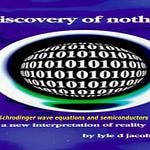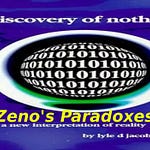Chapter 3: Electromagnetic Phenomena
Benjamin Franklin, printer, diplomat, and American icon, found time in his busy career to make major discoveries and innovation in electrostatics. Let us determine if they follow this binary zero and one pattern.
During Franklin's time, it was believed there were two types of electricity. If one silk cloth was rubbed on glass and another silk cloth was rubbed on amber and then both cloths were brought close together, the two silk cloths were attracted to each other and clung together.
Similarly, if two silk cloths were rubbed on glass and then brought close together, they repelled each other and moved apart. The same repulsion effect occurred when two silk cloths were rubbed against amber.
It was postulated there were two types of electricity. One involved with glass, vitreous, and the other with amber, resinous. Franklin noticed that after a time these attraction and repulsion effects disappeared and the silk cloths returned to their usual position with respect to each other.
From this observation, he came to the conclusion there was only one type of electricity. Franklin reasoned that when silk cloths were rubbed, one of these substances, glass or amber, gained an excess of this electricity, and the other was left with a deficit.
The one with the deficit had transferred an access to the silk cloth. The one with the excess had transferred the deficit to the other silk cloth. Franklin stated that after the two cloths came together in the attraction phase, each would eventually discharge and return to a balance of only one kind of electricity.
For this reason they separated and returned to their usual distance. And the repulsion effects ended for the same reason. Franklin concluded that excess and deficit attract each other and two excesses or two deficits repel each other.
He coined the term positive for the excess and negative for the deficit. It seems obvious two and a half centuries later why he did so. The excess of electricity is a positive addition process and the deficit of electricity is a negative subtraction process.
More than a century after Franklin's discoveries, it was learned that this single type of electricity represented particles of electrons. Franklin had no idea which material, glass or amber, had the excess and which had the deficit.
He guessed with a 50-50 probability of being right. Much later, it was found that he had guessed wrong. The excess electrons were at the negative pole instead of the positive pole as Franklin has intended. But instead of changing the sign to correspond with reality, convention prevailed.
It was reasoned that as long as electricians used the same nomenclature, the misnomer would still work for them. Even today, electricians are taught that the electron is at the positive pole. However, scientists discovered long after Franklin that electrons were at the negative pole.
Franklin's concept of an excess positive addition is now understood in physics to be a negative charge and his deficit negative subtraction concept is now a positive charge. This creates a major problem in how we view nature.
Consider this years that science students have looked at these designations in reverse. Calling a subtraction a deficit, positive, and an addition an excess, negative. The misnomer obscures the symmetry of nature. Subconsciously, we are blinded to the simplicity and the true meaning of positive and negative with the electromagnetic discipline.
This limits us in our ability to carry this binary symmetry into areas of nature. The terms positive and negative have become misleading and meaningless electromechanical identifiers. This causes us to miss the elegance of nature's underlying binary 0 and 1 principle.
Rubbing the silk generates the extra energy necessary for the electron to move from one place to another. It was the glass that emitted electrons and caused absorption on the silk. Amber absorbed the electrons emitted from the silk. After rubbing the glass, the glass then has a deficit of electrons and amber in excess. What is left when an electron leaves?
The glass now has an excess of holes where electrons used to reside, and glass also has a deficit of electrons. Amber now has a deficit of holes and an excess of electrons. Notice that in considering the organized spaces, as well as electrons, we have a duality of excess, 1, and deficit, 0, within each object, amber and glass.
Thus we are concentrating on both the physical electron and the non-physical hole. What does this mean? Could the same thing be happening down there at the atomic level as it is up there at the human level?
As individuals we are continually fluctuating between charged states. An example is the negative state of hunger, zero, that attracts us to the positive charge of food, one. The only difference in holes at the atomic level and the individual level is the size, shape and form of the holes and what fills and empties the holes.
Physicists know how these positive and negative electric charges act and can measure the size of charges, but they do not say anything about what they actually represent. They know the electron is somehow a part of one charge, but they can say nothing about the other charge.
I have concluded that we can now comprehend what charges are by making the hole and an entity along with the electron which oscillates in and out of the hole. The negative charge is the zero of the empty condition and the positive charge is the one electron of the filled condition. Before absorption, the absorber is in a negative empty condition and before emission, the absorber is in a filled positive condition.
Those objects absorbing electrons change to a positively charged state and those objects emitting electrons change to a negatively charged state. We can also extend the concepts of absorption and emission to holes as well as to the physical entities that fill and empty the holes.
The deficit, zero, can also be thought of as being absorbed and emitted.
In other words, we can say that when the one is absorbed, a zero is emitted and when the zero is absorbed, a one is emitted. It would seem that the zero is incapable of being absorbed and emitted. However, this is possible because the zero is a viable entity unto itself.
The exchange and interaction that the emitted and absorbed object creates between the emitter and absorber is an exchange between the zero and one. That which is emptied and that which is filled have changed positions. The body that absorbs and the body that emits change charges.
Emission for an object is moving from a positive, zero charge to a negative, negative charge and absorption for an object is moving from a negative minus charge to a positive plus charge. Our quest for answers should be equally directed toward both the 0 and the 1, which gives something and nothing equal status.
In explaining electrical charges, we must show the forces that cause the attraction and repulsion effects of electrical phenomena.
It is the zeros and ones affinity toward each other that causes the force of attraction? Does the zero want to be filled and does the one want to perform the fill? Is it the excess of ones in both silk bodies and the excess of zeros in both silk bodies that cause repulsion? Is it because there is no possibility of occupation that the move away from each other? If both 1's and 0's are conserved, corollary number 7, then it is obvious, after the fact, that a 0 cannot displace a 0 and a 1 cannot displace a 1.
If this were the case, then we would have the elimination of the 0 and 1, an unimaginable event that has not been seen in nature. Instead, ones move toward the zero where they can naturally flow and away from other ones where they cannot flow.
Attraction and Repulsion Forces
In the preface to this landmark Treates, “Principia Mathematica”, Isaac Newton reveals his optimism for a truer method of philosophy.
I wish we could derive the rest of the phenomena of nature by the same kind of reasoning from mechanical principles. For I am induced by many reasons to suspect that they may all depend upon certain forces by which the particles of bodies, by some causes hitherto unknown, are either mutually impelled towards one another and cohere in the regular figures, or are repelled and recede from one another.
These forces being unknown, philosophers have hitherto attempted to search of nature in vain, but I hope the principles here laid down will afford some light either to this or some truer method of philosophy.
Newton admitted he could not explain why bodies want to come together and adhere and why they repel and recede from one another. Instead, he concentrated on describing how physical bodies could be expected to react with one another through their motion, never mind why they did so.
For Newton, forces existed but could not be identified. This concentration on the physical alone and its reaction to unknown forces worked well enough until we enter the era of quantum physics.
From my view, the emergence of quantum mechanics and our focus on the physical has caused a crisis in our interpretations of reality. We can no longer afford to view nature in the context of the physical alone. In contrast, some have said that within the atomic domain we cannot even view nature at all.
Many within the physics community would pull down a curtain that covers explanations of nature by denying causality and a one-to-one correspondence with reality in the microcosm.
In so doing, they have instituted one set of rules for the microcosm and another set for macrocosm.
If we are going to continue postulating a universe governed by cause and effect, we must explain these forces of nature. With amazing foresight, Newton recognized this problem and alluded to the direction, the why of motion toward objects and the why of motion away from objects, we must go to achieve a truer method of philosophy.
I believe that direction lies toward identifying the why of the apart phase of the together phase, the why of emission and absorption. When we are hungry, our body is in a negative and empty state that attracts us to food causing us to move toward the food that will bring us back to a full and positive state.
This represents the empty zero of the human body having access to the one of food. Similarly, the zeros, empty, of one silk cloth are attracted to the ones, filled, of the other silk cloth and conversely the ones are attracted to the zeros.
If in search of food we find the refrigerator in an empty negative state, we are repelled away from it by our attempt to find the positive food. This is an empty zero, confronting an empty zero and being repulsed by it.
Similarly, the two silk cloths repelled each other due to the deficit zero of electrons in each. Can a filled one condition also repulse another filled one condition?
If we move to any container to fill it and discover it already full, we are repulsed away toward a container in an empty condition. We may conclude then that a 0 on 0 and a 1 on 1 encounter results in a repulsion effect. This is occurring in the microcosm and macrocosm for the same reason.
Do humans use the repulsion force at a distance in the same way the silk cloths repelled keeping distance between them? When our stomachs are full, we tend to keep a distance from the refrigerator knowing our filled one condition cannot achieve another fill one.
When we move through the halls/holes of our house, we naturally keep a safe distance from the physical walls that define our hallways, zero. This repulsion, one of humans to one of walls, at a distance is learned by the hard knocks that warn us where we can and cannot safely go.
Where we cannot go becomes our guide in directing us to where we can go. While driving in highways, a deadly repulsion effect can occur if we trespass beyond the borders of the road that keep us at a safe distance. We move away from the highway borders because we recognize the danger of a collision.
The collision we avoid is between the one of the border and the one of the car. This is a one-on-one of repulsion.
What causes us to move away from danger and keep a safe distance is the same principle that causes two silk cloths with an excess of electrons one-on-one to move a distance from each other. When where we cannot go becomes powerful enough, we move further away to better maintain the direction of where we can go.
Do repulsion effects at the atomic level occur for the same reason they do at the human level? I am suggesting that the binary concept of the zero and one can explain the forces humans use and electric charges use for motion away and toward.
The why of the apart phase is the repulsion, zero and zero and one on one. Force and the why of the together phase is the attraction, zero to one and one to zero, force.
The same forces are at work in the microcosm and the macrocosm.
Attraction is derived from the availability of the 1 and the 0 for each other. The positive one is attracted to the negative zero, and the negative zero is attracted to the positive one.
A zero can move to a fixed one, and a one can move to a fixed zero, or they can both move toward each other. How does a zero move to a one? When a truck is empty,zero , it uses its physical framework and energy of motion to move its emptiness toward the one of the full warehouse.
In the same way humans move their zeros towards the filled refrigerator. When the zero arrives at the one, then the one can move to displace the zero. This can be generalized to all human action and the tools we use to aid our emission zero and absorption one phases.
The oscillating zeros and ones of humans are oscillating negative and positive charges. The same principle is applicable to the oscillating zeros and ones of negative and positive electrical charges. All of nature's fluctuations are between these binary processes.
My conclusion is that the physical sciences have missed discovering the fundamental basis of physical phenomena because physicists have subconsciously isolated the physical from the non-physical.
Newtonian mechanics concentrated on matter. To solve our present problems, we need to apply equal concentration on the non-physical. It may appear that the physical world moves because of an attraction to the other physical objects.
In reality, when we conclude that the non-physical is organized and sculpted by the physical one, it follows that the attraction between objects is an attraction of the ones of each other to the zeros of each object and the zeros of each to the ones of each.
The motion (emission) resulting from this attraction acts with precision because the repulsion force 0 on 0 and 1 on 1 guides this attraction force 0 to 1 and 1 to 0.
Everything, including ourselves, knows where to go because it knows where it cannot go.













Share this post